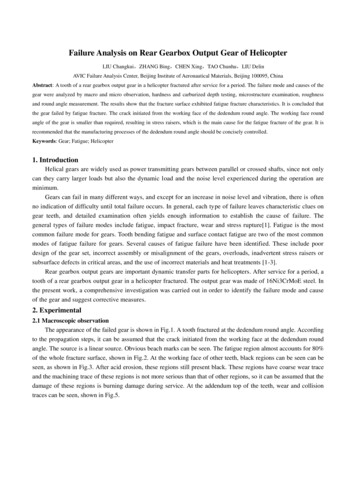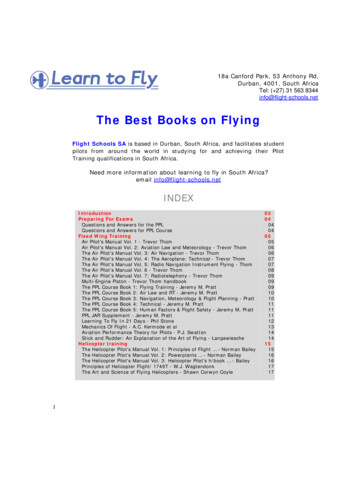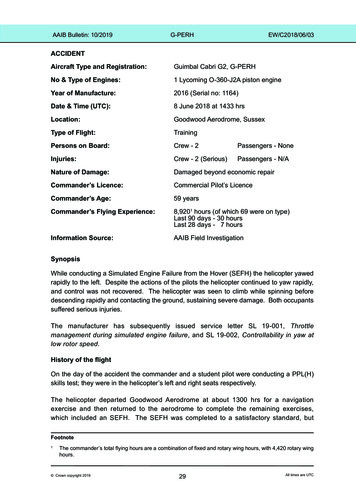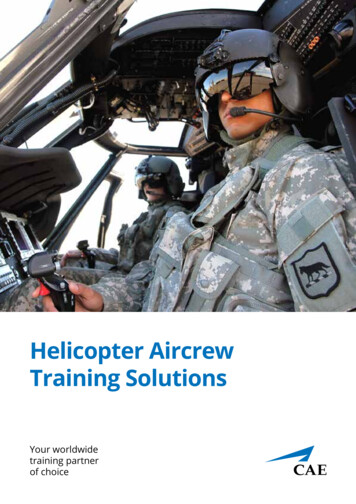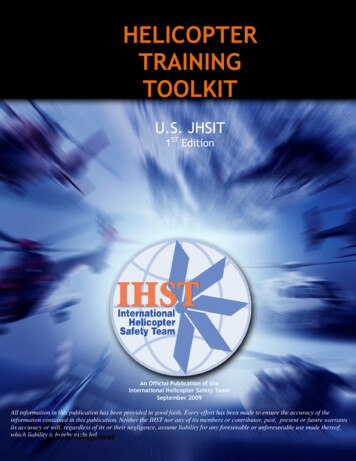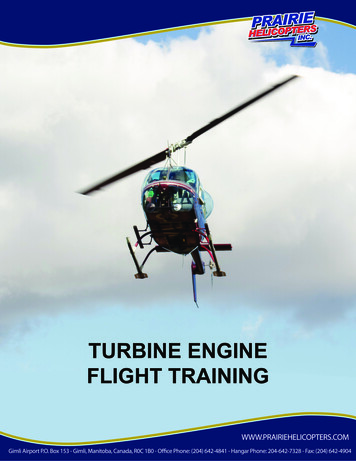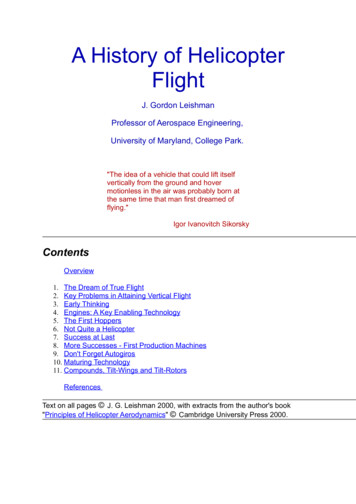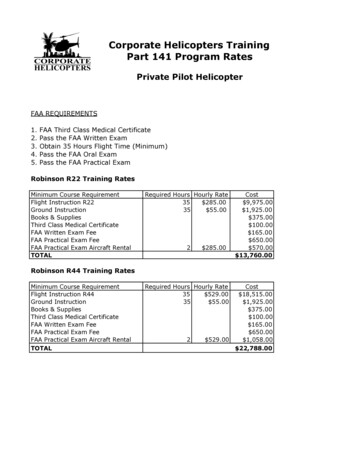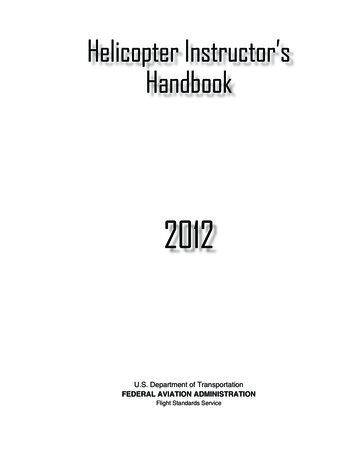
Transcription
Helicopter Instructor’sHandbook2012U.S. Department of TransportationFEDERAL AVIATION ADMINISTRATIONFlight Standards Service
ii
PrefaceThe Helicopter Instructor’s Handbook is designed as a technical manual for applicants who are preparing for their flightinstructor pilot certificate with a helicopter class rating. This handbook contains detailed coverage of aerodynamics, flightcontrols, systems, performance, flight maneuvers, emergencies, and aeronautical decision-making. Topics such as weather,navigation, radio navigation and communications, use of flight information publications, and regulations are available inother Federal Aviation Administration (FAA) publications.This handbook conforms to flight instructor pilot training and certification concepts established by the FAA. There aredifferent ways of teaching, as well as performing flight procedures and maneuvers, and many variations in the explanationsof aerodynamic theories and principles. Occasionally the word “must” or similar language is used where the desired actionis deemed critical. The use of such language is not intended to add to, interpret, or relieve a duty imposed by Title 14 ofthe Code of Federal Regulations (14 CFR).This handbook is available for download, in PDF format, from www.faa.gov.This handbook is published by the United States Department of Transportation, Federal Aviation Administration, AirmanTesting Standards Branch, AFS-630, P.O. Box 25082, Oklahoma City, OK 73125.Comments regarding this publication should be sent, in email form, to the following address:AFS630comments@faa.goviii
iv
AcknowledgmentsThe Helicopter Instructor’s Handbook was produced by the Federal Aviation Administration (FAA) with the assistance ofSafety Research Corporation of America (SRCA). The FAA wishes to acknowledge the following contributors:NZ Civil Aviation Authority for image of safety procedures for approaching a helicopter (Chapter 1)David Park (www.freedigitalphotos.net) for image used in Chapter 2Paul Whetstone (www.meyersaircraft.com) for image used in Chapter 5Burkhard Domke (www.b-domke.de) for images used in Chapter 5Bishop Equipment Mfg. Inc (www.bishopequipment.com) for image used in Chapter 6Terry Simpkins of FLYIT Simulators (www.flyit.com) for image used in Chapter 13Additional appreciation is extended to W.A. (Dub) Blessing, HAI Outstanding CFI award 1985; Donovan L. Harvey (1928to 2000), HAI Outstanding CFI award 1987; Neil Jones, CFI; Chin Tu, CFI; the Helicopter Association International (HAI),Aircraft Owners and Pilots Association (AOPA), and the AOPA Air Safety Foundation for their technical support and input.v
vi
Table of ContentsPreface.iiiAcknowledgments.vTable of Contents.viiChapter 1Introduction to Flight Training.1-1Purpose of Flight Training.1-1Practical Flight Instructor Strategies.1-2The Federal Aviation Administration (FAA).1-3Role.1-3FAA Reference Material.1-3Role of the Examiner.1-5Role of the Certificated Flight Instructor (CFI).1-5Flight Safety Practices.1-6Helicopter Hazards.1-6Instructional Hazards.1-8Collision Avoidance.1-9See and Avoid.1-9Positive Exchange of Flight Controls.1-10Single-Pilot Resource Management (SRM).1-10Risk Management.1-11Chapter Summary.1-12Chapter 2Introduction to the Helicopter.2-1Introduction.2-1Training Procedures.2-2Introduction to the Helicopter.2-2Introduction to Flying.2-3Instructor Tips.2-4Chapter Summary.2-6Chapter 3Aerodynamics of Flight.3-1Introduction.3-1Forces Acting on the Aircraft.3-2Lift.3-2Bernoulli’s Principle.3-2Newton’s Laws of Motion.3-2Thrust.3-4Drag.3-5Airfoil.3-6Blade Twist.3-6Rotor Blade and Hub Definitions.3-7Airflow and Reactions in the Rotor System.3-7Rotor Blade Angles.3-8Hovering Flight.3-8Translating Tendency or Drift.3-10Pendular Action.3-10Coning . .3-10Coriolis Effect (Law of Conservation of AngularMomentum).3-11Ground Effect .3-11Gyroscopic Precession.3-12Forward Flight.3-12Translational Lift.3-12Translational Thrust.3-13Induced Flow.3-13Transverse Flow Effect.3-13Dissymmetry of Lift.3-13Hover.3-13Translational Flight.3-14Sideward, Rearward, and Turning Flight.3-14Autorotation.3-15Entry.3-15Steady-State Descent.3-15Deceleration.3-15Instructor Tips.3-16Chapter Summary.3-16Chapter 4Helicopter Flight Controls.4-1Introduction.4-1Collective Pitch Control.4-2Throttle Control.4-3Cyclic Pitch Control .4-4Antitorque Control.4-5Practice.4-6Instructor Tips.4-6Chapter Summary.4-6vii
Chapter 5Helicopter Components, Sections, andSystems.5-1Introduction.5-1Airframe Design.5-2Rotor Blade Design.5-2Powerplant Design.5-2Antitorque System Design.5-2Landing Gear System sadvantages.5-3Composite elage.5-4Main Rotor System.5-4Rigid Rotor System.5-5Semirigid Rotor System.5-5Fully Articulated Rotor System.5-8Bearingless Rotor System.5-10Tandem Rotor.5-10Coaxial Rotor System.5-11Swashplate Assembly.5-12Antitorque Systems.5-14Tail Rotor.5-14Other Types of Antitorque System.5-14Engines.5-16Reciprocating Engine (Piston).5-16Turbine Engine.5-16Compressor.5-18Combustion Chamber.5-18Turbine.5-18Transmission System.5-19Main Rotor Transmission.5-19Antitorque Drive System.5-20Clutch.5-20Freewheeling Unit.5-20Fuel System.5-21Engines.5-21Reciprocating Engines.5-21Carburetor.5-21Carburetor Ice.5-22Fuel Injection.5-22Electrical Systems.5-23Hydraulics.5-23Hydraulic System Components.5-23Hydraulic System Failure.5-24Stability Augmentation Systems (SAS).5-24Autopilot.5-25viiiEnvironmental Systems (Heating/Cooling).5-25Anti-Icing Systems.5-25Engine Anti-Ice.5-25Carburetor Icing.5-25Preflight and Deicing.5-26Instructor Tips.5-26Chapter Summary.5-26Chapter 6Rotorcraft Flight Manual.6-1Introduction.6-1Introducing the Manual.6-2Sections of the Manual.6-2General Information (Section 1).6-2Operating Limitations (Section 2).6-2Emergency Procedures (Section 3).6-4Normal Procedures (Section 4).6-4Performance (Section 5).6-5Weight and Balance (Section 6).6-6Aircraft and Systems Description (Section 7).6-6Handling, Servicing, and Maintenance (Section 8).6-6Supplements (Section 9).6-7Chapter Summary.6-8Chapter 7Weight and -2Determining Empty Weight.7-2Balance.7-3Center of Gravity (CG).7-3CG Forward of Forward Limit.7-3CG Aft of Aft Limit.7-3Lateral Balance.7-4Ballast.7-4Weight and Balance Calculations.7-4Weight Versus Aircraft Performance.7-5Arm (Station).7-5Moment.7-5Weight and Balance Methods.7-6Computational Method.7-6Loading Chart Method . .7-6Combination Method.7-8Calculating Lateral CG.7-9Instructor Tips.7-10Chapter Summary.7-10Chapter 8Helicopter Performance.8-1Introduction.8-1
Factors Affecting Performance.8-2Density Altitude.8-2Weight.8-3Loads.8-3Load Factor.8-3Wind.8-4Height/Velocity Diagram.8-4Performance Planning.8-5Instructor Tips.8-5Chapter Summary.8-6Chapter 9Preflight and Postflight ed Documents.9-2Preflight Inspection.9-3Cockpit Management.9-4Ground Operations.9-5Engine Start.9-6Taxiing.9-7Before Takeoff.9-7After Landing.9-7Parking.9-7Engine Shutdown.9-9Postflight.9-9Securing and Servicing.9-9Instructor Tip.9-9Chapter Summary.9-9Chapter 10Basic Flight Maneuvers.10-1Introduction.10-1Basic Maneuvers.10-2Straight-and-Level Flight.10-2Instructional Points.10-2Common Student Difficulties.10-3Visualizing tion.10-3Scan.10-3Kinesthesia.10-3Normal Climb.10-4Instructional Points.10-4Common Student Coordination.10-5Scan.10-5Normal Descent.10-5Instructional Points.10-5Common Student n.10-5Turns .10-5Instructional Points.10-6Common Student Difficulties.10-6Attitude.10-6Leaning Away From a Turn.10-6Failure to Clear the Area.10-6Rolling Out of a Turn.10-6Climbing and Descending Turns.10-6Instructional Points.10-6Common Student n Exercises .10-7Approaches.10-7Instructional Points.10-8Common Student Difficulties.10-8Ground Track.10-8Altitude.10-8Airspeed.10-8Approach Angle.10-8Traffic.10-9Power Adjustments.10-9Go-Around.10-9Instructional Points.10-9Common Student Difficulties.10-9Initiating the Go-Around.10-9Coordination.10-9Normal and Crosswind Takeoff From a Hover.10-9Instructional Points.10-9Crosswind Considerations During Takeoffs.10-10Common Student Difficulties.10-10Attitude Control.10-10Heading Control.10-10Crosswind al Takeoff to a Hover and Hovering.10-11Instructional Points.10-11Common Student Difficulties.10-13Hovering Turn.10-14Instructional Points.10-14Common Student Difficulties.10-15ix
Hovering Forward.10-16Instructional Points.10-16Common Student Difficulties.10-16Hovering Sideward.10-16Common Student Difficulties.10-17Hovering Rearward.10-17Instructional Points.10-17Common Student Difficulties.10-17Landing From a Hover.10-18Instructional Points.10-18Common Student Difficulties.10-18Taxi.10-19Air Taxi.10-19Surface/Ground Taxi.10-19Instructional Points.10-19Ground Reference Maneuvers.10-20Rectangular Course.10-20S-Turn.10-21Turns Around a Point.10-21Common Student Difficulties.10-22Failure To Plan Properly.10-22Coordination.10-22Division of Attention.10-22Attitude.10-22Scan.10-22Instructor Tips.10-22Chapter Summary.10-24Chapter 11Advanced Flight Maneuvers.11-1Introduction.11-1Instructor’s Approach.11-2Scenario-Based Training.11-2Identification, Prevention, and Recovery.11-2Reinforce Fundamentals.11-2Reconnaissance Procedures.11-2High Reconnaissance.11-3Low Reconnaissance.11-3Ground Reconnaissance.11-4Maximum Performance Takeoff.11-4Instructional Points.11-4Common Student ning/Rolling Takeoff.11-5Instructional Points.11-5Common Student Difficulties.11-6RPM.11-6Attitude Control.11-6Wind.11-6xRapid Deceleration or Quick Stop.11-6Instructional Points.11-6Common Student ep Approach to a Hover.11-7Instructional Points.11-8Common Student Difficulties.11-8Shallow Approach and Running/Roll-On Landing.11-8Instructional Points.11-9Common Student Difficulties.11-9Approach Angle.11-9Attitude Control.11-9Collective Control.11-10Touchdown.11-10Slope Operations.11-10Slope Landings.11-10Instructional Points.11-11Common Student Difficulties.11-12Slope Takeoff.11-12Instructional Points.11-12Common Student Difficulties.11-12Confined Area Operations.11-12Instructional Points.11-13Approach and Landing.11-13Takeoff.11-14Common Student Difficulties.11-15Pinnacle and Ridgeline Operations.11-15Pinnacle Landings.11-15Instructional Points.11-15Common Student Difficulties.11-16Planning.11-16Approach Angle.11-16Airspeed.11-16Pinnacle Takeoff and Climb.11-16Instructional Points.11-16Common Student 11-17Night Flying.11-17Common Student ach.11-17Instructional Points.11-17Cross-Country Operations.11-18Instructional Points.11-18Common Student Difficulties.11-18
Poor Cross-Country Planning.11-18Reliability on Navigation Equipment.11-18Instructor Tips.11-18Chapter Summary.11-20Student Tendencies.13-5Instructional Objectives.13-6Instructor Tips.13-6Chapter Summary.13-7Chapter 12Helicopter Emergencies.12-1Introduction.12-1Autorotative Descents.12-2Straight
The Helicopter Instructor’s Handbook is designed as a technical manual for applicants who are preparing for their flight instructor pilot certificate with a helicopter class rating. This handbook contains detailed coverage of aerodynamics, flight controls, systems, performance, flight
